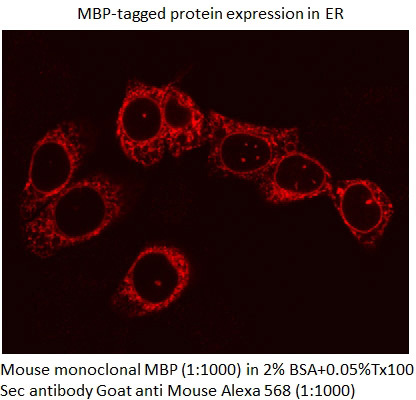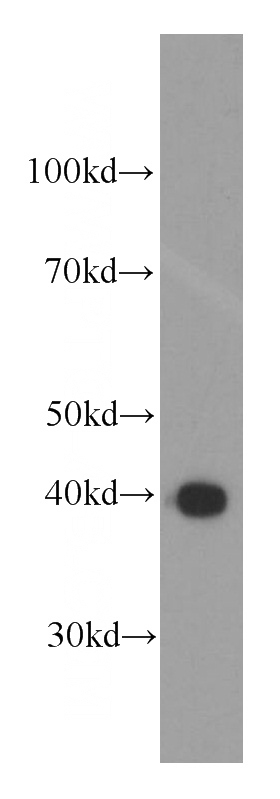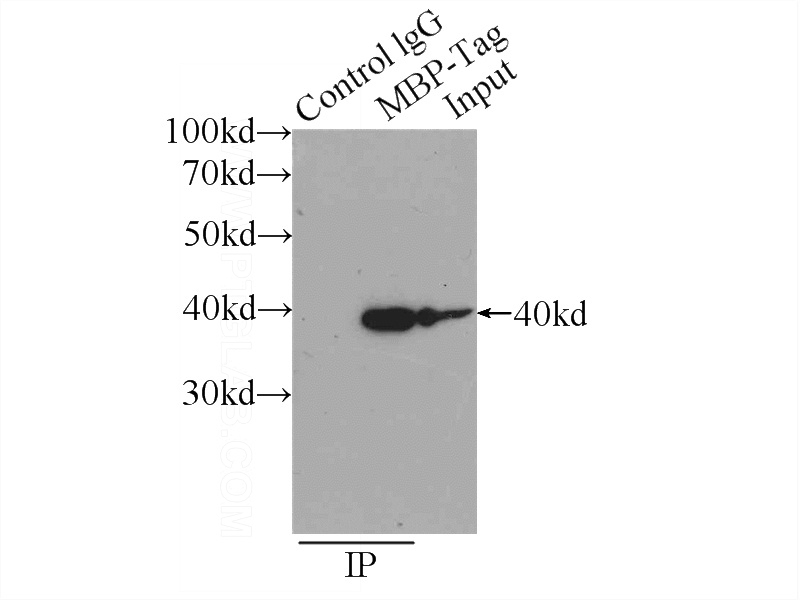-
Product Name
MBP tag antibody
- Documents
-
Description
MBP tag Mouse Monoclonal antibody. Positive IP detected in Recombinant protein protein. Positive WB detected in Recombinant protein. Positive IF detected in Transfected cells. Observed molecular weight by Western-blot: 40 kDa
-
Tested applications
ELISA, WB, IP, IF
-
Species reactivity
Tag
-
Alternative names
Maltose Binding Protein antibody; MBP antibody; MBP Tag antibody
-
Isotype
Mouse IgG2a
-
Preparation
This antibody was obtained by immunization of MBP tag recombinant protein. Purification method: Protein A purified.
-
Clonality
Monoclonal
-
Formulation
PBS with 0.02% sodium azide and 50% glycerol pH 7.3.
-
Storage instructions
Store at -20℃. DO NOT ALIQUOT
-
Applications
Recommended Dilution:
WB: 1:2000-1:20000
IP: 1:5000-1:50000
IF: N/A
-
Validations

IF result of MBP tag antibody (Catalog No:117330, 1:1,000) with MBP-Tagged protein.Courtesy of Neeraj Tiwari, PhD, Yale School of Medicine, Yale University.

Recombinant protein were subjected to SDS PAGE followed by western blot with Catalog No:117330(MBP-Tag antibody) at dilution of 1:4000

IP Result of anti-MBP-Tag (IP:Catalog No:117330, 5ug; Detection:Catalog No:117330 1:20000) with Recombinant protein protein lysate 800ug.
-
Background
Protein tags are protein or peptide sequences located either on the C- or N- terminal of the target protein, which facilitates one or several of the following characteristics: solubility, detection, purification, localization and expression. Maltose binding protein(MBP) is the 370 amino acid product of the E.coli mal E gene. MBP is a useful affinity tag that can increase the expression level and solubility of the resulting tagged protein. The MBP tag also promotes proper folding of the attached protein. Plasmid vectors have been constructed utilizing the MBP domain that allow the synthesis of high levels of MBP-fusion proteins that can be purified in a one step procedure by affinity chromatography cross linked amylose resin. Once bound to amylose, the MBP protein can then be separated from the target protein by cleavage by coagulation Factor Xa at a specific four residue site. Alternatively, the intact fusion protein can be specifically eluted from the resin by the addition of excess free maltose. Subsequent to elution, MBP fusion protein can be visualized either by Western blot analysis or immunoprecipitation using antibodies specific for the MBP-tag. An antibody to MBP can also be used to isolate or detect expression of the protein.
-
References
- Li Y, Wang W, Cheng D. A New Member of the TBC1D15 Family from Chiloscyllium plagiosum: Rab GTPase-Activating Protein Based on Rab7 as a Substrate. Marine drugs. 13(5):2955-66. 2015.
Related Products / Services
Please note: All products are "FOR RESEARCH USE ONLY AND ARE NOT INTENDED FOR DIAGNOSTIC OR THERAPEUTIC USE"
